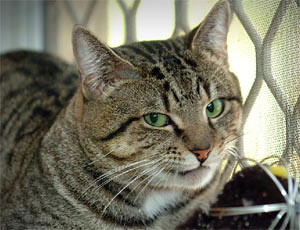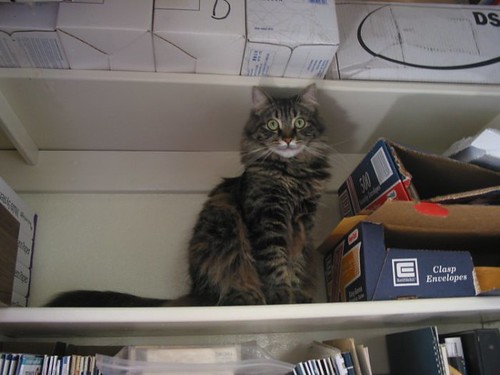Is Mr. Fluffandstuff being naughty? Are your punishment techniques unsuccessful at getting
results? A new approach to “bad behavior” may help you change how you look at your cat and find solutions that work for both of you.
results? A new approach to “bad behavior” may help you change how you look at your cat and find solutions that work for both of you.
There are often times when we may find ourselves at wits end with our cat. However, most behaviors that cats are punished for are actually normal, they just may not be what we humans consider acceptable.
Unfortunately, there is a lot of outdated or just plain inaccurate information about punishing cats available. Whether you heard it from your veterinarian, your friend or the internet, we’re here to tell you that all types of physical punishment are not only detrimental to your relationship with your cat, but they JUST DON’T WORK. Physical punishment has many negative effects on your relationship with your cat. The first thing you may notice is that your cat starts to
cower whenever you approach it with your hands. For fearful cats, this will only reinforce their fear of humans.
The other thing that happens is that punishment can turn a sweet cat into an aggressive one. If you swat or spank your cat, he may feel that you are “escalating” the situation or provoking it to fight. Many cats respond to a nosetap with a bite or swat – not exactly the response you may have been expecting…especially if you were looking for guilt or remorse.
Cats have a fairly limited concept of punishment. Many people assume that their cat “knows” it is being bad, because it does something wrong, such as scratching the furniture, and then skulks away. In fact, the cat is just associating the presence of its owner with being yelled at. He is not recognizing that scratching the couch is bad – again, to your kitty, scratching is a normal
behavior (that also happens to feel good, and that may be reward enough to risk being yelled at).
Many cats engage in problematic behaviors out of boredom. Just as with children, they may see “negative” attention (such as being yelled at) better than no attention at all. Often, in the case of a very bored cat who isn’t getting enough mental stimulation, humans actually reward negative behaviors by shouting. In this situation, the cat is looking for some sort of response from the
human – that reaction is frequently enough of a reward that the cat will knock things off your dresser or scratch your furniture, even if he knows he may get in trouble for it.
So, do we just give up and let the cats do whatever they want? The answer is an unequivocal, no. But, there are ways to “correct” bad behavior that are much more effective than yelling or hitting your cat. Cats learn by trial and error. If they try something and have a good experience, they will do it again. If they try something and have a bad experience, the behavior is more likely to be extinguished – although not always immediately. Sometimes they will keep trying
in hopes that the good experience will return – just as humans will play the slot machines time and time again, hoping for the “big payoff” – before finally giving
up.
Here's an easy 4 step plan!
1. Prevention: Give your cat an appropriate outlet for “normal” feline behaviors
2. Use correction, but only when appropriate
3. Use Remote punishment to discourage undesirable behaviors
4. Reward to reinforce good behaviors
I have identified two of the most common reasons people will punish their cats below.
Scratching Furniture
The most common cause of furniture scratching is a lack of an appropriate
scratching post. Since the couch fulfills most of the cats scratching needs (tall,
sturdy, a material they like to scratch, and in an easily accessible location), it
seems like the best place to sharpen those claws.
To work with this behavior:
1. Give your cat an adequate scratching post. Scratching is a natural behavior, and necessary for all cats – it’s how they stretch, mark their territory, relieve stress and shed their claws.
2. Correction or punishment, such as yelling or squirting with a water bottle, is not appropriate in this case. Cats learn quickly that the punishment only happens when humans are around, and will just return to scratching furniture when you leave. They may also scratch furniture, anticipating some attention (remember, to a bored cat, negative attention may be better than no attention at all).
3. Make the furniture an unappealing place to scratch by using tin-foil, double sided tape, or a product called Sticky Paws. These are all unpleasant sensations for a kitty trying to scratch.
4. Encourage your cat to use the scratching post by using treats, toys or catnip to lure them into a natural stretching position. Praise them for using their post instead of the couch.
You can also read our “Paws and Claws” handout for more information on training cats to use a scratching post.
Climbing on Furniture/Knocking Over Items
Cats love to be up high. They also need lots of mental stimulation. When they don’t have outlets for these needs, they may start climbing up on your dresser, kitchen table or counters. In a playful mode, they may start batting at small objects, trying to knock them off. Not only does this provide them with some playful activity, but they may get a response from their human out of it, as well.
1. Start by giving your kitty its own cat condo or high-up places to hang out (you can clear off some shelves and put fleece pads on them to make them more appealing. More interactive playtime with toys such as the cat dancer or feather wand, in addition to solo play toys (ping pong balls, fuzzy mice) will provide more mental stimulation.
2. As in the case of other attention seeking behaviors, punishment is not effective for this behavior, and may just reinforce it.
3. Make counters and other surfaces unappealing – you can use cookie sheets or pieces of cardboard with tin foil or double sided tape attached to them. You can also “booby-trap” the area with empty soda cans with a few pennies taped inside – when the cat jumps up on the counter, the noise of the cans being knocked over will be a deterrent. Keep in mind,
this deterrent is not a good idea with shy cats or in multi-cat households where a non-guilty kitty may be scared off by the punishment.
4. Praise the kitty for using its cat tree, and make it a fun place to be – try placing some catnip, or solo play toys on the cat tree. Try incorporating the kitty condo into your interactive playtime – get your cat climbing or jumping on it to chase a toy.
So, with a little understanding, a watchful eye and maybe a little preventive re-arranging of your environment, your relationship with your furry roomates can stand the test of time!!






No comments:
Post a Comment